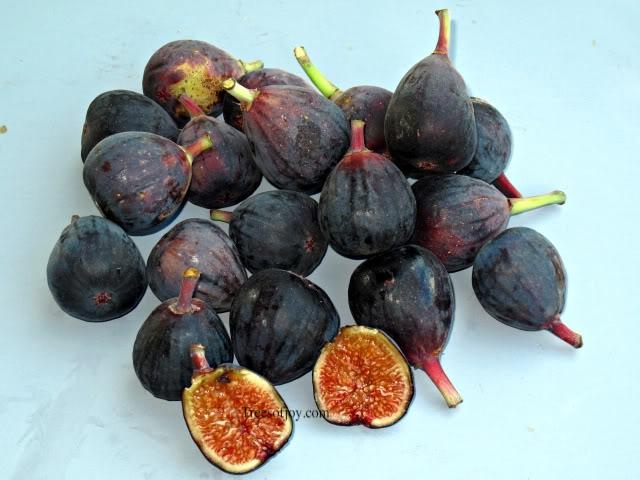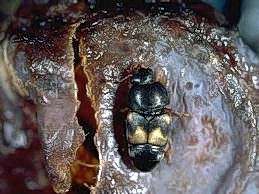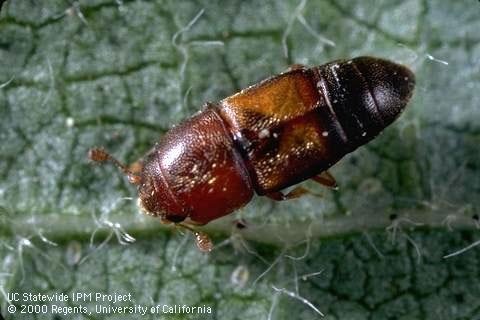Beetles Have an Eye Out for Figs
Help for the Home Gardener from the Contra Costa Master Gardener Help Desk
Client's Problem:
CCMG Help Desk's Response:
I'm responding to your telephone inquiry yesterday about a problem with your Mission Fig. I under stand that you have observed little black insects on the tree branches which are about the size of a flea but may be beetles. You also reported that something is infecting the figs. Some figs are getting black inside and may have some fungal growth.
It is likely that the small insects that you have observed are the cause of the problem with the rotting figs. The insects may be dried fruit and/or sap beetles. There are several closely related species of this insect. The adults are small brown or black beetles with or without lighter spots on the wings, depending on the species, They range in size from 0.1 to 0.2 inch long and have clubbed antennae. The wings do not cover the last two to three abdominal segments. The larvae are white and 0.1 to 0.2 inch long when mature. Here are photos showing two different species of such beetles:
As figs mature, the fruit often develops an entry point at the eye of the fig which the beetles use to gain entry into the soft fruit tissue. They can also enter the fruit at other openings in the fruit caused by mechanical injury or by other insects. After they enter the fruit, the beetles transmit spoilage organisms that cause the fruit to sour and ferment. The rotting figs in tum can attract other pests such as vinegar files and navel orange worms. The beetle larvae feed inside the fruit until they are mature enough to emerge and drop to the ground where they pupate and emerge as adult beetles.
To manage an infestation of the beetles the University of California recommends that you promptly remove and destroy all infected fruit. You may want to dispose of the rotting fruit in a plastic bag in your garbage to stop reproduction and spread of the beetles. You should remove any infected fruit from the tree and also promptly and thoroughly remove any fruit that drops to the ground.
UC also recommends trapping the beetles in a container with an inverted cone top. You can find a link to a drawing of such a container at this UC Davis website: http://www.ipm.ucdavis.edu/PMG/GARDEN/FRUIT/PESTS/driedfrtbeetle.html. You bait the trap with fermenting figs and water. You could also add some bakers yeast to speed up the fermentation process in the trap. If you decide to try traps, check them every couple of days and remove trapped beetles. Also replenish the water if needed.
As new figs start developing on your tree, check them carefully to try to detect and remove any that may have been invaded by the beetles. You may want to try harvesting on the early side of ripeness to reduce the chances that the beetles will have gained entry into the fruit.
UC also reports that fig varieties with small eyes (like a Mission fig) are less likely to be infected by the beetles than fig varieties with large eyes. The fact that your Mission fig appears to have been attacked by the beetles demonstrates that even they are not immune to attack.
As a final caution, the beetles can also infect other fruit such as stone fruits (e.g., peaches, plums, cherries, etc.) and citrus. So if you have such trees, keep an eye out for a problem. Early removal of any infected fruit and thorough and quick clean-up of fruit that drops to the ground would also help manage the problem in other fruit trees.
Hope this information is helpful. You are welcome to contact us again if you have further questions.
Contra Costa Master Gardeners' Help Desk
Editor's Note: The Contra Costa Master Gardener Help Desk is available year-round to answer your gardening questions. Except for a few holidays, we're open every week, Monday through Thursday from 9:00 am to Noon at 75 Santa Barbara Road, 2d Floor, Pleasant Hill, CA 94523.
We can also be reached via telephone: (925) 646-6586, email: ccmg@ucanr.edu, and we are on the web at http://ccmg.ucanr.edu/










